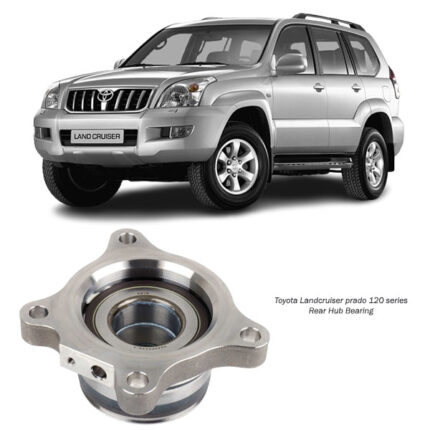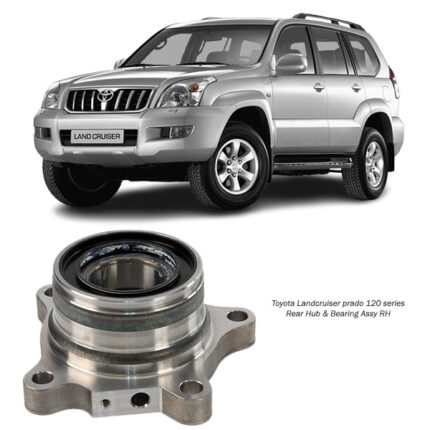-6%
Get Toyota Landcruiser prado 120 series Rear Shock Absorber Assy 341372 in Kenya
Ever wonder how your ride stays smooth even over bumpy roads? Or how your vehicle stays stable when cornering, accelerating, or braking? That smooth, controlled experience is made possible by an essential suspension component—the Rear Shock Absorber Assembly.
While it quietly does its job behind the scenes, this powerful component is crucial to your safety, comfort, and driving experience. Let’s explore what it is, how it works, and why it’s one of the most important parts of your vehicle’s suspension system. 🧠🛞
What is the Rear Shock Absorber Assembly? 🤔🔧
Let’s break down the name:
-
Rear – Located on the back axle, supporting the rear half of the vehicle.
-
Shock Absorber – A hydraulic or gas-filled component that dampens and controls the impact and rebound of suspension movement.
-
Assembly – Refers to the complete unit, which may include the shock body, mounting hardware, bushings, and sometimes an integrated spring (in the case of coilover designs).
So, the Rear Shock Absorber Assembly is a complete unit designed to absorb and dampen the bouncing motion caused by road irregularities, keeping the rear wheels in contact with the road and ensuring a stable, smooth ride. 🚗💨
The Function: More Than Just “Absorbing Shocks” 🌀⚙️
Despite the name, shock absorbers don’t just absorb shocks—they control suspension movement. Without them, your vehicle would bounce uncontrollably every time it hit a bump or dip.
Here’s what the rear shock absorber assembly actually does:
-
Dampens Suspension Travel – Controls how fast the rear suspension compresses and rebounds.
-
Improves Stability – Keeps the tires firmly planted on the ground, especially on rough terrain.
-
Enhances Comfort – Reduces vibrations and jolts for passengers.
-
Maintains Traction – Prevents rear tires from skipping or hopping during braking or over uneven surfaces.
-
Reduces Wear – Helps reduce wear on tires, brakes, and other suspension components.
In essence, rear shocks turn chaos into control. Every bump, pothole, or dip is managed with quiet efficiency. 🌉🔩
How It Works: Hydraulics in Harmony 💧🔩
Inside each rear shock absorber is a piston, hydraulic fluid, and a cylinder (or tube). Here’s how it works:
-
When the rear wheel hits a bump, the suspension compresses, forcing the shock absorber to shorten.
-
As the piston moves through the fluid, it creates resistance by pushing the fluid through tiny holes or valves.
-
This resistance slows down the motion of the suspension, turning kinetic energy into heat.
-
When the bump is passed, the shock expands back at a controlled rate, preventing the vehicle from bouncing.
Some rear shock assemblies are gas-charged, using nitrogen gas to prevent fluid foaming and improve consistency, especially in performance or off-road conditions. 🛞🔥
Common Types of Rear Shock Absorbers 🛠️🔍
There are several types of rear shock assemblies used across different suspension systems:
-
Twin-Tube Shocks – Most common; two cylinders (inner and outer) hold fluid and gas separately.
-
Mono-Tube Shocks – More advanced; one larger cylinder provides better cooling and consistent damping.
-
Coilover Shocks – Combine the shock with a coil spring around the body; used for performance or lifted vehicles.
-
Air Shocks – Use air pressure to adjust ride height or firmness; often found in luxury or towing vehicles.
Each design has its strengths, but they all share one goal: balance control and comfort for the rear of the vehicle. 🔄🛠️
Signs of a Worn or Failing Rear Shock Absorber 😬⚠️
Shock absorbers don’t last forever. Over time, they wear out from constant movement, heat, and exposure. Here are common signs of wear:
-
Bouncing or Swaying – Excessive rear-end bounce after hitting bumps or dips.
-
Leaking Fluid – Visible oil or fluid on the shock body means the internal seals are failing.
-
Clunking or Rattling Noises – Indicates loose mounts or damaged internals.
-
Uneven Tire Wear – Especially on the rear tires; shocks can’t keep the tire properly planted.
-
Nose Diving or Squatting – Rear of the vehicle sags during acceleration or feels unstable when braking.
If any of these symptoms appear, it’s time to inspect and likely replace the rear shock absorber assemblies. 🔍🔧
Why It Matters: The Driving Experience 🎯🛣️
A properly functioning rear shock absorber assembly provides:
-
✅ Controlled handling through corners and curves
-
✅ Reduced stopping distance by keeping tires in full contact with the road
-
✅ Improved comfort on long drives or rough terrain
-
✅ Balanced load support during acceleration or towing
-
✅ Longer lifespan for suspension and tire components
Think of it as the guardian of your rear wheels, making sure everything stays in check, no matter what the road throws your way. 🛡️🚘
Rear Shocks vs. Front Shocks: What’s the Difference? 🔄📍
While both serve the same purpose, rear and front shocks are often tuned differently:
-
Rear shocks deal more with load balance and vertical movement, especially when carrying passengers or cargo.
-
Front shocks are more involved in steering control and handling dynamics.
Because of this, rear shocks might be longer, softer, or designed to support heavier loads, especially in SUVs or utility vehicles. 🧳🏋️♂️
Replacement and Installation Process 🔧⏱️
Replacing a rear shock absorber assembly is typically straightforward but should always be done in pairs (both sides) for balanced performance.
Basic steps include:
-
Lifting the vehicle and safely removing the rear wheel.
-
Unbolting the old shock from top and bottom mounts.
-
Installing the new assembly, ensuring all bushings, bolts, and torque specs are correct.
-
Rechecking ride height, wheel alignment, and road testing for performance.
Professional installation ensures proper fitment and optimal handling. 🧰✅
Maintenance Tips: Keep Your Ride Smooth 🧼🛞
-
🔍 Inspect shocks regularly – Especially after 80,000–100,000 km.
-
💦 Clean off mud and debris to prevent premature corrosion.
-
🛞 Check tire condition and alignment – It affects and reflects shock absorber performance.
-
🛣️ Drive cautiously over rough roads – Sudden impacts can damage shock internals.
-
🛠️ Use OEM or quality aftermarket parts – Cheap replacements may not offer reliable performance.
Keeping your rear shock absorbers in good condition goes a long way toward maintaining a smooth, safe driving experience. 🔧💡
Final Thoughts: The Comfort Behind Every Curve 🌄✨
The Rear Shock Absorber Assembly might not get the attention that flashy wheels or engine mods do—but it plays an irreplaceable role in the way your vehicle feels and performs.
From reducing rear-end bounce to helping maintain tire contact on slippery roads, it works every second your vehicle is in motion. When it’s in top shape, you’ll feel the difference in every ride—stable, quiet, and smooth.
So the next time you enjoy a peaceful cruise or a steady stop at a red light, give a mental nod to your rear shocks. They’re doing more work than you realize—silently keeping everything under control.
Follow us on Facebook for more parts.




Reviews
Clear filtersThere are no reviews yet.